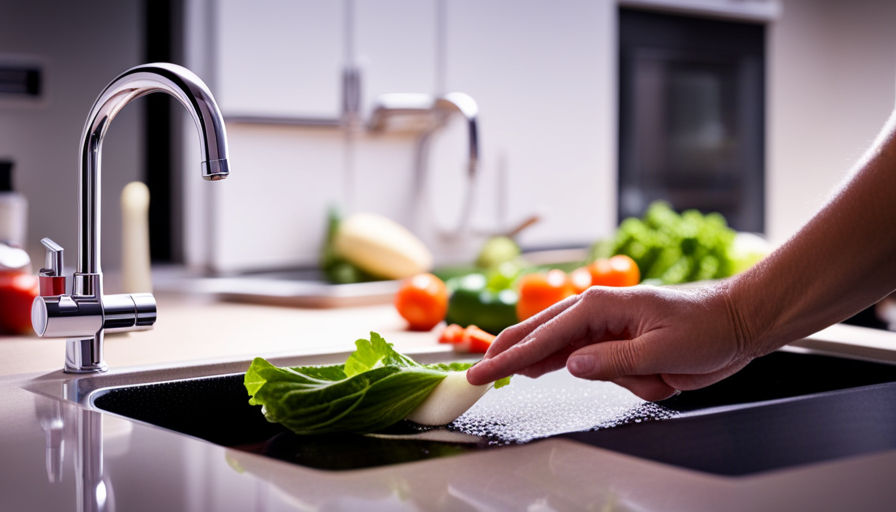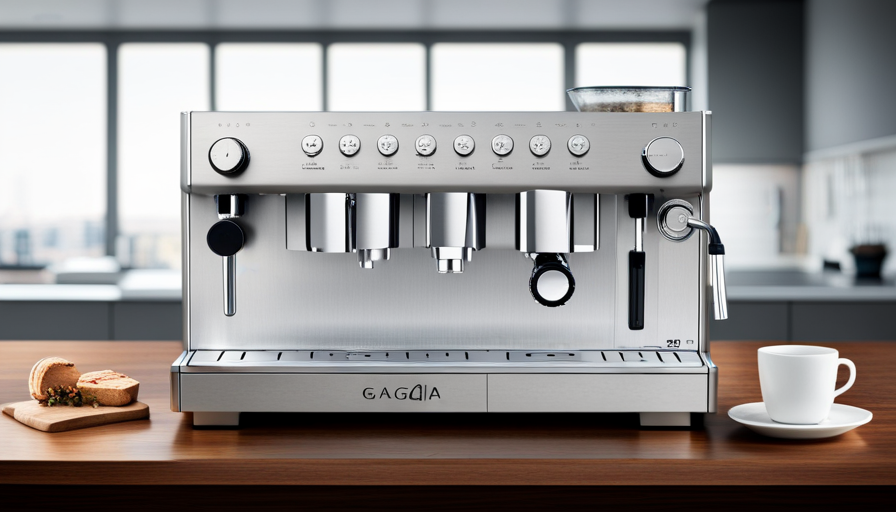Were you aware that around 48 million people in the United States fall ill from foodborne illnesses annually, as reported by the Centers for Disease Control and Prevention (CDC)?
That’s a staggering statistic that highlights the importance of proper handwashing practices in the kitchen, especially when handling raw food. As a food safety specialist, I understand the critical role that clean hands play in preventing the spread of harmful bacteria and viruses.
In this article, I will provide you with meticulous instructions on how to wash your hands in the kitchen when handling raw food. From using warm water and soap to scrubbing your hands for at least 20 seconds, I will guide you through each step to ensure maximum cleanliness. I will also share relevant facts and scientific information to support these recommendations, drawing upon food safety regulations and best practices established by regulatory bodies.
By following these tips, you can protect yourself and your loved ones from foodborne illnesses and create a safe and hygienic kitchen environment.
Let’s dive into the world of handwashing and discover the key practices for maintaining food safety in the kitchen.
Key Takeaways
- Proper handwashing practices in the kitchen are crucial for preventing the spread of harmful bacteria and viruses.
- Using warm water and soap is essential for effective handwashing.
- Hands should be scrubbed for at least 20 seconds, paying attention to areas between fingers and under nails.
- Drying hands properly and avoiding touching surfaces after washing helps prevent cross-contamination.
Understand the importance of handwashing
You may think that a quick rinse of your hands is enough, but understanding the importance of thorough handwashing is crucial in preventing the spread of harmful bacteria when handling raw food in the kitchen.
As a food safety specialist, I know that proper handwashing is the first line of defense against foodborne illnesses. It not only removes visible dirt and grime, but also reduces the spread of germs that can make you and your family sick.
To effectively wash your hands in the kitchen, start by wetting your hands with warm water. This helps to loosen any dirt or bacteria on your hands. Next, apply soap and lather well, making sure to cover all surfaces, including between your fingers and under your nails. Rub your hands together vigorously for at least 20 seconds, as this is the minimum time needed to effectively remove germs. Rinse your hands thoroughly under warm running water, ensuring all soap is washed away.
Understanding the importance of handwashing and following these steps will help to prevent the spread of harmful bacteria when handling raw food.
Now, let’s move on to the next step: using warm water and soap.
Use warm water and soap
To effectively clean, make sure to use warm water and soap when handling raw ingredients in the kitchen. Hand hygiene is crucial in preventing the spread of harmful bacteria and viruses that can cause foodborne illnesses. Proper handwashing techniques are essential in maintaining food safety standards.
Start by wetting your hands with warm water. The warm temperature helps to loosen dirt and oil on your skin. Apply enough soap to cover your entire hand, including the back, between fingers, and under the nails. Rub your hands together vigorously, creating a lather. Pay attention to each area of your hands, ensuring that every surface is thoroughly cleaned. Don’t forget to scrub your wrists as well.
Continue rubbing your hands for at least 20 seconds to effectively eliminate any bacteria or pathogens. Rinse your hands thoroughly under running water, making sure to remove all the soap. Dry your hands using a clean towel or air dryer.
By following these proper handwashing techniques, you can significantly reduce the risk of cross-contamination and keep your kitchen safe and sanitary.
Transitioning into the next section, it’s important to remember that handwashing is just the first step in maintaining proper food hygiene.
Scrub your hands for at least 20 seconds
Make sure to scrub your hands vigorously for at least 20 seconds, ensuring that every surface is thoroughly cleaned. To properly wash your hands in the kitchen when handling raw food, it is crucial to follow effective handwashing techniques. Proper hand hygiene is essential in preventing the spread of harmful bacteria and reducing the risk of foodborne illnesses.
To help you visualize the process, refer to the table below that outlines step-by-step instructions for washing your hands:
| Step | Action | Duration |
|---|---|---|
| 1 | Wet your hands | 5 seconds |
| 2 | Apply enough soap to cover all surfaces | 5 seconds |
| 3 | Rub your hands palm to palm | 5 seconds |
| 4 | Rub the back of each hand | 5 seconds |
| 5 | Rinse your hands thoroughly | 5 seconds |
Following these steps will ensure that you adequately remove any potential contaminants from your hands. Remember, effective handwashing is crucial in maintaining food safety standards.
Now, let’s transition to the next section about paying attention to the areas between fingers and under nails.
Pay attention to the areas between fingers and under nails
Ensuring the areas between your fingers and under your nails are thoroughly cleaned will help protect against harmful bacteria and promote better hand hygiene. When it comes to washing your hands in the kitchen, these areas are often overlooked, but they can harbor bacteria and pathogens that can contaminate your food.
To effectively clean these areas, start by lathering your hands with soap and water. Then, interlace your fingers and rub them together, paying close attention to the spaces in between. Use your fingertips to scrub the areas under your nails, gently removing any dirt or debris. Rinse your hands thoroughly, making sure to remove all the soap residue.
By focusing on these areas, you can significantly reduce the risk of cross-contamination and foodborne illnesses.
Moving on to nail care, it’s essential to keep your nails short and clean. Long nails can trap dirt and bacteria, making it harder to clean them effectively. Trim your nails regularly and use a nail brush to scrub underneath. This will ensure that your hands are properly cleaned and ready to handle raw food safely.
Transitioning to the next topic, it’s equally important to use a clean towel or air dry your hands to avoid recontamination.
Use a clean towel or air dry your hands
Don’t forget to grab a fresh, clean towel or let the air work its magic, leaving your hands dry and ready for anything.
When it comes to hand hygiene in the kitchen, drying your hands properly is just as important as washing them. Using a clean towel or air drying helps to remove any lingering moisture that can harbor bacteria. A study conducted in public spaces found that proper hand drying reduced bacterial contamination by up to 77%. So, take the time to thoroughly dry your hands to ensure optimal cleanliness.
For children, handwashing techniques should be taught from an early age. Encourage them to use warm water and soap, making sure they wash all the areas, including between fingers and under nails. It’s also important to emphasize the importance of drying hands properly. Teach them to use a clean towel or let their hands air dry, just like adults.
Now that your hands are dry, it’s crucial to avoid touching surfaces as much as possible. By doing so, you prevent recontamination and maintain the cleanliness you just achieved. Remember, the key is to be mindful and diligent in practicing good hand hygiene, both in the kitchen and in public spaces.
Avoid touching surfaces after washing your hands
To maintain proper hand hygiene while handling raw food in the kitchen, it’s crucial to be mindful of cross-contamination prevention. After thoroughly washing your hands with soap and warm water, it’s important to avoid touching any surfaces that may be contaminated.
This includes faucet handles, drawer handles, or any other kitchen utensils or equipment that may have come into contact with raw food. Cross-contamination can occur when bacteria from raw food is transferred to other surfaces or food items, leading to potential foodborne illnesses. By refraining from touching surfaces after washing your hands, you can significantly reduce the risk of cross-contamination.
In addition, always remember to dry your hands thoroughly after washing them. Moisture can promote the growth of bacteria, so using a clean towel or allowing your hands to air dry is essential.
By following these steps and being meticulous in your hand hygiene practices, you can effectively minimize the risk of cross-contamination and ensure the safety of your food.
Next, we’ll discuss the importance of washing your hands before and after handling raw food.
Wash your hands before and after handling raw food
Before and after you handle raw food, it’s important to remember that proper hand hygiene is crucial in preventing the spread of harmful bacteria. Studies have shown that not washing your hands can increase the risk of foodborne illnesses by up to 31%. To ensure you’re effectively washing your hands in the kitchen when handling raw food, follow these steps:
- Wet your hands with warm water and apply enough soap to create a good lather.
- Rub your hands together vigorously for at least 20 seconds, making sure to cover all surfaces, including the backs of your hands, between your fingers, and under your nails.
- Rinse your hands thoroughly under running water.
- Dry your hands completely using a clean towel or air dryer. Remember, the proper hand drying technique is equally important as wet hands can easily transfer bacteria.
When handwashing is not possible, such as when you’re outdoors or in a busy kitchen, it’s important to use hand sanitizer with at least 60% alcohol content. However, keep in mind that hand sanitizer should never replace proper handwashing when handling raw food.
Now that you know how to properly wash your hands, let’s move on to the next important step: using disposable gloves when necessary.
Use disposable gloves when necessary
When it comes to handling raw food in the kitchen, it’s crucial to maintain proper hygiene to prevent cross-contamination and foodborne illnesses. In addition to washing your hands before and after handling raw food, there are instances where using disposable gloves is necessary.
Disposable gloves provide an extra layer of protection and can be particularly useful when dealing with raw meat, poultry, or fish, as they may contain harmful bacteria. However, it’s essential to note that disposable gloves aren’t always the best option. They can create a false sense of security and may lead to poor hand hygiene practices if not used correctly.
Alternatives to disposable gloves include using utensils or tools to handle raw food directly or washing hands thoroughly after each contact.
When using disposable gloves, it’s crucial to follow best practices. Start by washing your hands thoroughly before putting on the gloves to ensure they’re clean. Choose gloves that fit well and are appropriate for the task at hand. Remember to change gloves regularly, especially when switching between different types of food or after performing other tasks, such as handling trash or cleaning surfaces.
Using disposable gloves correctly can help minimize the risk of cross-contamination, but it shouldn’t replace proper handwashing. After removing the gloves, always wash your hands thoroughly with soap and warm water.
By incorporating these best practices for using disposable gloves, you can ensure proper hygiene in the kitchen when handling raw food.
Now, let’s move on to the next important step: cleaning and sanitizing kitchen surfaces regularly.
Clean and sanitize kitchen surfaces regularly
Make sure you regularly clean and sanitize the surfaces in your kitchen to create a safe and hygienic environment. Proper cleaning and sanitizing of kitchen surfaces is essential when handling raw food to prevent cross-contamination and the spread of harmful bacteria. Here is a step-by-step guide on how to effectively clean and sanitize your kitchen surfaces:
| Step | Action | Explanation |
|---|---|---|
| 1 | Wash | Use warm water and dish soap to thoroughly wash all surfaces, including countertops, cutting boards, and utensils. This helps remove dirt, grease, and visible debris. |
| 2 | Rinse | Rinse the surfaces with clean water to remove any remaining soap residue. |
| 3 | Sanitize | Apply a sanitizing solution, such as a mixture of bleach and water or a commercial sanitizer, to the surfaces. Follow the manufacturer’s instructions for proper dilution and contact time. |
| 4 | Air dry or wipe | Allow the surfaces to air dry or use a clean towel to wipe them dry. Avoid using the same towel for multiple surfaces to prevent cross-contamination. |
In addition to regular cleaning and sanitizing, it is crucial to store raw food properly to minimize the risk of contamination. Store raw meat, poultry, and seafood in sealed containers on the bottom shelf of the refrigerator to prevent any juices from dripping onto other foods. Remember to separate raw foods from ready-to-eat foods to avoid cross-contamination.
Transition: Now that you know how to clean and sanitize your kitchen surfaces, it’s important to educate others on proper handwashing techniques.
Educate others on proper handwashing techniques
To ensure the health and safety of those around you, it’s crucial to teach others the proper way to wash their hands – it’s like giving them the key to a fortress, protecting against the invasion of harmful bacteria.
When handling raw food in the kitchen, proper handwashing techniques are essential to prevent cross-contamination and the spread of foodborne illnesses.
Here’s a step-by-step guide on how to wash hands in the kitchen when handling raw food:
-
Wet your hands with clean, running water. Adjust the temperature to warm.
-
Apply enough soap to cover all surfaces of your hands.
-
Rub your hands together vigorously for at least 20 seconds, making sure to lather the backs of your hands, between your fingers, and under your nails.
-
Rinse your hands thoroughly under clean, running water.
-
Dry your hands with a clean towel or air dryer.
Proper handwashing removes dirt, germs, and bacteria from your hands, reducing the risk of contamination. It’s especially important when handling raw food, as it can harbor harmful pathogens like Salmonella and E. coli. By following these steps and practicing good hand hygiene, you can protect yourself and others from foodborne illnesses.
Frequently Asked Questions
Are disposable gloves necessary when handling raw food in the kitchen?
Disposable gloves aren’t necessary when handling raw food in the kitchen. Cross contamination can be prevented by thoroughly washing hands with soap and warm water for at least 20 seconds before and after handling raw food. This helps remove any potential pathogens that may be present. It’s important to focus on proper handwashing techniques, including scrubbing between fingers and under nails, to ensure effective removal of bacteria and other harmful microorganisms.
How often should I clean and sanitize kitchen surfaces when handling raw food?
When handling raw food in the kitchen, it’s crucial to maintain a high cleaning frequency and prioritize proper sanitation. Regularly cleaning and sanitizing kitchen surfaces is essential to prevent the spread of harmful bacteria and cross-contamination.
I recommend cleaning surfaces before and after each use, particularly when dealing with raw food. This includes countertops, cutting boards, utensils, and any other surfaces that come into contact with raw food.
By maintaining a meticulous cleaning routine, you can ensure a safe and hygienic kitchen environment.
Can I use hand sanitizer instead of soap and water when washing my hands in the kitchen?
Using hand sanitizer as an alternative to soap and water may seem convenient, but it’s not as effective in removing certain types of contaminants, such as chemicals and pesticides. Proper hand hygiene in the kitchen is crucial to prevent foodborne illnesses.
To ensure thorough handwashing, follow these steps:
- Wet hands with clean, running water.nn2. Apply soap and rub hands together for at least 20 seconds.nn3. Rinse well.nn4. Dry with a clean towel or air dry.
Should I wash my hands before or after handling raw food?
When handling raw food, it’s crucial to wash your hands both before and after. Proper handwashing technique is of utmost importance to prevent the spread of harmful bacteria and potential foodborne illnesses. Not washing hands before handling raw food can contaminate the food, while not washing hands afterwards can lead to cross-contamination in the kitchen.
By washing your hands thoroughly with soap and water for at least 20 seconds, you can effectively remove any bacteria and reduce the risk of foodborne illnesses.
How can I educate others on proper handwashing techniques in the kitchen?
To educate others on proper handwashing techniques in the kitchen, I would recommend utilizing educational resources and interactive demonstrations.
These resources can include informative videos, online articles, and handwashing posters that clearly outline the necessary steps.
Interactive demonstrations, such as live workshops or hands-on training sessions, can provide a more engaging and practical learning experience.
By emphasizing the importance of handwashing and providing specific instructions, we can ensure that individuals understand the crucial role it plays in food safety.
What Are the Best Practices for Washing Hands When Handling Raw Food in the Kitchen?
When handling raw food in the kitchen, it’s crucial to follow best practices for washing hands. After touching raw food, always wash hands with soap and warm water for at least 20 seconds. Using separate utensils for raw and cooked food can also minimize the risk of cross-contamination and foodborne illnesses.
Conclusion
In conclusion, proper handwashing is crucial when handling raw food in the kitchen. It’s as essential as wearing a seatbelt while driving, ensuring our safety and well-being.
Remember to use warm water and soap, and scrub your hands for at least 20 seconds. Pay attention to the areas between fingers and under nails.
Dry your hands with a clean towel or air dry them.
Educate others on the importance of handwashing to protect themselves from harmful bacteria.
Stay safe and keep your kitchen clean!










